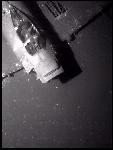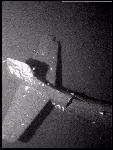Supervisory Control
of Untethered Undersea Systems:
A New Paradigm Verified
Richard Uhrich & James Walton
Naval Command, Control and Ocean Surveillance Center
RDT&E Division, Code 561
53560 Hull Street
San Diego, CA 92152-5000
Presented at the Ninth International Symposium on Unmanned Untethered
Submersible Technology, Durham NH, September 25, 1995.
Abstract
![[AUSS]](t_auss-s.jpg
) The primary advantage of untethered underwater systems is freedom from cables.
Tethered systems benefit from realtime human control based upon immediate
information received from the remote vehicle. This paper describes a
well-proven system which has the advantages of both, and proposes that the
concepts utilized therein offer exciting new possibilities for exploring and
exploiting the deep ocean.
The primary advantage of untethered underwater systems is freedom from cables.
Tethered systems benefit from realtime human control based upon immediate
information received from the remote vehicle. This paper describes a
well-proven system which has the advantages of both, and proposes that the
concepts utilized therein offer exciting new possibilities for exploring and
exploiting the deep ocean.
Introduction
The Advanced Unmanned Search System (AUSS) features an underwater vehicle which is both unmanned and untethered, yet not strictly autonomous. Communication with a surface ship is accomplished by means of underwater sound, as employed by a sophisticated digital acoustic link. Operation is analogous to radio-controlled robotic space probes: the vehicle generally proceeds on its own intelligence while transmitting status information and mission data, but it can receive new instructions at any time. AUSS is, in fact, far more versatile than a probe, with such abilities as going to a newly commanded location, hovering at a specified altitude and location, executing a complete search pattern, or returning home on command.Acoustic Communication
A popular science and technology magazine, in a recent issue devoted to the oceans, divided undersea vehicles into three categories: manned submersibles, remotely operated vehicles (ROVs), and autonomous underwater vehicles (AUVs). It described ROVs as having unwieldy tethers, "wire, fiber-optic, or acoustic." The Advanced Unmanned Search System (AUSS) was uniquely depicted as acoustically tethered. (Presumably, the Hubble Space Telescope is "electromagnetically tethered.") On the other hand, the Eastern University's experimental autonomous vehicle (EAVE III) is classified as an AUV with acoustic telemetry, and Dick Blidburg is referenced as describing communications as being at the forefront of AUV technology.At what point does communication make an AUV an ROV? Obviously the practice of classifying unmanned underwater vehicles as either ROVs or AUVs is unsatisfactory for free-swimming vehicles with communications, especially those capable of accepting real- time commands. We will resist the temptation to introduce yet another acronym (eg., Semi-autonomous Unmanned Untethered Undersea Vehicles), and will refer to them as semi-autonomous or supervised vehicles.
Supervisory Control
Just as acoustic telemetry is the only viable means of real-time, long-range untethered underwater communication, the only form of control is supervisory. True joystick-type remote control would require full-time downlink transmission, which would drown out uplink communications, leaving a pilot both blind and without instruments.Like a purely autonomous vehicle, a supervisory controlled one is not encumbered by a cable, the proverbial tail which wags the dog of deep towed or tethered systems. Thus it can move at relatively high speeds and perform sharp, precise maneuvers, or it can hover stably without expending power fighting cable pull. Furthermore, the operators are relieved of tedious piloting and navigation functions, because all critical loops are closed on the vehicle. In effect, they have a remote autopilot: they can even direct the vehicle to go to a location miles away, then go to lunch trusting it to be waiting there when they return.
On the other hand, with supervisory control, operational decisions need not be preprogrammed or based on limited machine intelligence. As with a tethered vehicle, the operator can make operational decisions based on detailed, up-to-date information, and can immediately see the results of new commands. Decision thresholds and control loop parameters themselves can be reprogrammed on the fly. Objects or geographic areas of major interest can be both identified and fully explored on the same dive rather than on subsequent ones, thereby saving considerable time and resources. Even the response to critical or emergency situations can be flexible. If new information warrants, the operators can make decisions which instantly and totally redirect the mission.
Deep Search
The premise of search is that a known object is lost on the ocean floor, the location known at best approximately. The objective is to determine the location of that object, or to verify that it is not within the suspected area. The two types of general purpose underwater search sensors employed are sonar and optical. The product of either is images. The width of sonar images can be hundreds or even thousands of feet, whereas optical images are usually limited to a few tens of feet. For a given vehicle speed, a sonar search is much faster than its optical counterpart.On the other hand, long range is obtained at the cost of resolution. Unless the object of the search is a nearly intact ship or submarine, sonar is unlikely to unambiguously distinguish it from worthless objects, termed false targets. A search system must do more than identify the location of all likely or possible targets; it must confirm whether each is the object sought.
Generally, a search is not considered finished until a human sees optical images of the real target or of all potential targets.
AUSS Search And Inspection
The purpose of AUSS is to improve the Navy's capability to locate, identify and inspect objects on the bottom of the ocean at depths to 20,000 feet. The vehicle utilizes sophisticated search sensors, computers, and software, and it is self-navigating. When commanded to do so, it can autonomously execute a predefined search pattern at high speed, while continuously transmitting compressed side-looking sonar images to the surface. The operators evaluate the images and supervise the operation. If they wish to investigate a sonar contact, they can order the vehicle to temporarily suspend sonar search and swim over for a closer look using its scanning sonar or still-frame electronic camera. Each camera image is also compressed and transmitted to the surface. If the operators see that the contact is not the object sought, a single command causes the vehicle to resume the search from where it left off.



Exploration of a Skyraider Aircraft
Once the object sought is recognized, a detailed optical inspection can be conducted immediately. Many options are available during the inspection phase. Previously transmitted images can be retransmitted at higher resolution. New optical images can be requested from different altitudes and positions. A documentary film camera can be turned on or off. AUSS can back away and perform more sonar scans at higher resolution or longer range. If the object of interest is very large or found to be highly fragmented, the vehicle can perform a small photomosaic search pattern, taking overlapping pictures guaranteeing total optical coverage of a defined area.
Autonomous Search
Imagine an AUV designed to perform deep search. The broad-area, side-looking sonar phase would be simple, but inspection would be a different matter. A rather simple AUV could merely swim a predefined search pattern, at a safe altitude, while recording sonar data. When done, it could be recovered and dump its data. Humans would study the sonar images, then redeploy the AUV to fly low over all potential targets and take pictures or photomosaics, when appropriate. This type of search would be inefficient and costly, requiring two full deployments and the inspection of all possible targets even if the very first target was the one sought.An AUV only slightly smarter than the AUSS vehicle might recognize strong or unusual sonar returns, and close and photograph each one it finds in the defined search area, all in one deployment. A really smart AUV might even be capable of optically recognizing certain objects, and be authorized to terminate the search when it thinks the job is done. We would want such an AUV to be conservative, erring to search too much area rather than failing to find the object or failing to prove it not to be in the search area. It would therefore investigate many false sonar targets, often "seeing" the sought object but continuing the search because it wasn't "sure" of what it saw.
In either case, simple or smart, only after the AUV returned and humans reviewed the optical images could the search director be told whether the object was found or the area was thoroughly searched. Detailed inspection, if required, would await an ROV or a manned submersible.
Even if autonomous search were to be proven reliable, it would almost certainly be slower and more expensive than supervised search. An AUV, deprived of human expertise, insight and curiosity, could not perform inspection and exploration as AUSS does.
Generalizing The Concept
We have found supervisory control ideal for deep search and inspection. What other tasks might be better performed with supervisory control? More simply, what AUV would not benefit from the ability to communicate?There are some missions which require acoustic silence, and there are ones wherein noise or geometry make acoustic communications physically impossible. There are cases where the mission is so simple or the cost of failure so low that communication is of little importance. However, if communication can be used, why not let humans monitor the remote system, handle unexpected situations, recognize difficult objects and make important decisions in real time?
A vehicle system designed from the start with supervisory control in mind will not likely turn out to be just an AUV with an acoustic link added on. It would probably employ completely different methods than previously considered, which might result in broader capabilities with a system which is simpler overall than a purely autonomous one.
Summary
The greatest strength of AUSS is its versatility, the system's ability to adapt to new situations or knowledge, both during operations and between operations. Years of operational experience with the system have led to the evolution of radically different, and highly efficient search tactics. The attributes of AUSS which have made it a versatile search and inspection system are primarily a result of acoustic supervisory control. This technology is now well proven and ready to be applied to a wide range of undersea tasks which are now performed by towed, tethered, or manned systems.Bibliography
Mackelburg, G. R., S. J. Watson, and W. D. Bryan. 1992. "Advanced Unmanned Search System (AUSS) Acoustic Communication Link Development." NRaD TR 1531 (Nov). Naval Command, Control and Ocean Surveillance Center, RDT&E Division, San Diego, CA.
Uhrich, R. W., and S. J. Watson. 1992. "Deep-Ocean Search and Inspection: Advanced Unmanned Search System (AUSS) Concept of Operation." NRaD TR 1530 (Nov). Naval Command, Control and Ocean Surveillance Center, RDT&E Division, San Diego, CA.
Walton, J. 1992. "Evolution of a Search System: Lessons Learned with the Advanced Unmanned Search System." NRaD TR 1529 (Nov). Naval Command, Control and Ocean Surveillance Center, RDT&E Division, San Diego, CA.
This technology is covered by U.S. Patents #5,018,114, 4,905,211, 4,432,079 and 4,418,404 and others assigned to the U.S. Government. Parties interested in licensing this technology may direct inquiries to Legal Counsel for Patents, Code 0012.
Address all questions/comments to:
[email protected]
Last update: 2 December 1998
